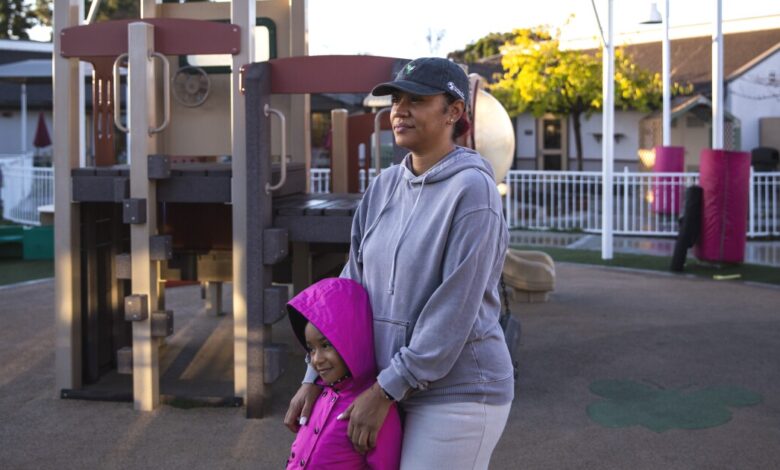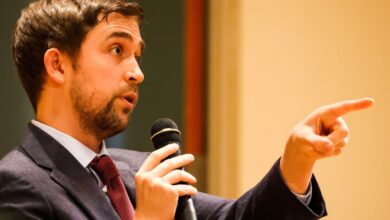The Pandemic Accelerates a Decline in Campus-Based Child Care

[ad_1]
During the first few months of the pandemic, Stephanie Dotson, a student at Long Beach City College, tried to study from home with her 3-year-old daughter. It wasn’t easy.
“You’re trying to take care of your kid and the professor is talking,” she said. “Thank goodness for the mute button.”
Then, last winter, a spot opened up in the campus day care. It was only half-day, so she still had to cram her classes into a three-hour window, but at least she got some uninterrupted study time.
“It was a big, big relief,” she said.
Many student parents haven’t been so lucky. At least half a dozen colleges have shuttered their child care centers for good since the pandemic struck, accelerating a yearslong decline in campus-based care that’s been driven by high costs, low wages, and inadequate state and federal support.
In 2004 roughly 60 percent of public colleges had campus child care centers. By 2019 only 45 percent did. The steepest losses have occurred at community colleges, which educate 42 percent of all student parents.
When the University of Vermont announced in May 2020 that it wouldn’t reopen its Campus Children’s School, Loren Dow, a graduate student who had just finished her dissertation, had a moment of panic.
“It was really scary to think, ‘What if our son can’t find a place for child care, then what’s next for my career?’” said Dow, who also worked in the athletics department at the time. “I put in all that work, and then potentially I’m going to be a stay-at-home mom.”
The bottom line is, if you don’t have child care, you don’t go to class.
Even before Covid-19 forced millions of parents to work and study from home while caring for their children and supervising their schoolwork, just 18 percent of student parents earned an associate or bachelor’s degree within six years. Now, amid a pandemic that has decimated an already fragile child care sector, advocates for student parents worry that even fewer of them will graduate on time, if at all.
“The bottom line is, if you don’t have child care, you don’t go to class,” said Nicole Lynn Lewis, founder and chief executive of Generation Hope, which advocates for teen and student parents. “Child care is one of the most formidable obstacles for student parents.”
For the students, as well as faculty and staff members affected by the closures, finding a new spot in a community-based center isn’t easy. Many day cares are operating at reduced capacity because of health restrictions or staff shortages, and some 20,000 have shut down permanently, according to estimates by the Center for American Progress.
Some student parents, like Mena Sylvester, an undergraduate at George Mason University with a 6-year-old daughter, are leaning on family and friends for coverage during class. Others are working less or taking fewer classes, shrinking their income or extending their time to a degree. Some have dropped out entirely.
In a Lumina-Gallup poll conducted in the fall of 2020, 44 percent of student caregivers said they had considered stopping out, compared with 31 percent of students without such responsibilities.
But advocates like Lewis see hope in a sweeping social spending bill under debate in the U.S. Senate that could significantly expand the supply of affordable child care on campuses and nationwide. Under the Build Back Better bill, which Democrats hope to clear before Christmas, low- and middle-income families would pay little or nothing for child care, and all families would be eligible for free pre-kindergarten. Millions more families would be able to afford care, and wages for child care workers would increase.
“Parenting students and their children bear the brunt of how inaccessible and inequitable both the higher ed and early childhood systems are,” said Lewis. “This is an opportunity to do something about that.”
The Pandemic’s Toll
Campus child care centers have always operated on razor-thin margins. Though they’re eligible to collect state subsidies for serving low-income families, the vouchers don’t usually cover the full cost of care. Federal grants can help fill the gap, but centers must compete for them every four years, and not every center gets one. Smaller centers often lack the staffing to even apply, said Stacey Smith-Clark , president of the National Coalition for Campus Children’s Centers, which has roughly 600 members.
Some centers are supported through student fees, but that funding isn’t guaranteed, either. If a majority of students at a college are childless, they may begin to wonder, “Why should I be funding this?” said Smith-Clark, who manages the center at Long Beach City College.
The pandemic has put campus-based centers in an even more precarious position. Many centers lost revenue when they were forced to close, and nearly all faced new costs for cleaning products, masks, and other personal protective equipment when they reopened.
Families didn’t rush to re-enroll their children, either. In cities and towns where school systems remained remote or hybrid last year, many parents stayed home to support their older children, and kept their younger kids home, too.
Some centers are still undersubscribed, a year and a half after the initial shutdown, and with most schools now open.
Among them are the City University of New York’s 17 centers, where 95 percent of the clients are students. Sherry Cleary , university dean of early childhood initiatives at CUNY, attributes the sluggish recovery to the fact that many of the system’s parenting students are still studying online themselves. She’s optimistic the numbers will rebound in the spring, when 70 percent of CUNY’s classes will be held in person.
Some centers are still undersubscribed, a year and a half after the initial shutdown.
At Edmonds College’s center, in Lynnwood, Wash., enrollment is half what it was before Covid hit, according to the director, Lisa Neumann. She thinks fear is a factor.
“Many parents are still fearful of the virus and of their children bringing it home,” she said.
Other center directors said demand is back to pre-pandemic levels, but they can’t find the staff to cover the classrooms. Child care has always been a challenging, low-paid profession, and the pandemic has made it a risky one, too.
The larger of Amarillo College’s two centers is licensed to serve 135 students, but currently has only 78 because of staffing shortages, according to Dennis Sarine, director of teacher preparation and early childhood education. The Texas community college has struggled to fill several part-time positions, even though several local centers have shut down, displacing their staff, Carine said.
Neumann, at Edmonds, said she has enough interested parents to open a small preschool classroom, but she doesn’t have the teachers. She said she’d have to raise tuition significantly to pay her teachers what they could earn in the local school system.
“Child care was in crisis before the pandemic, and now it’s collapsing,” she said.
In at least one respect, though, campus-based centers may be better positioned to weather the pandemic than their community-based counterparts: Most of them don’t pay rent or utilities to their landlord (the college). In some cases, the institution will cover additional costs or a shortfall, too.
But for many cash-strapped colleges, that’s become a challenge.
An Under-Documented Lifeline
Even when they’re operating at full capacity, campus-based child care centers serve only a tiny fraction of the millions of students, faculty members, and staff who are raising children. That fact alone can make it difficult for centers to justify their cost to campus administrators, said Smith-Clark.
When centers are losing money, it becomes even harder for advocates to argue for continuing them — especially since there’s little proof that they improve student outcomes.
The best and most frequently cited statistics come from Monroe College, which found that student parents who used its center had one and a half times the fall-to-fall persistence and three times the graduation rate of student parents who didn’t.
But there have been no controlled studies comparing how students who use campus centers fare with how their peers do, in part because most colleges don’t treat parents as a distinct demographic group, said Lindsey Reichlin Cruse, who until recently was managing director of the Student Parent Success Initiative at the Institute for Women’s Policy Research. The Free Application for Federal Student Aid may give college leaders a sense of which applicants have dependents, but they don’t often disaggregate the data.
For the student parents who depend on them, campus centers can be a lifeline, offering not only child care, but access to a broader network of supports.
As a result, “they don’t understand the connection between what they see as an employee benefit and the bottom line of increasing persistence and completion,” Cruse said.
But for the student parents who depend on them, campus centers can be a lifeline, offering not only child care, but access to a broader network of supports. If a parent is struggling emotionally or academically, or needs help securing financial aid or an emergency grant, the staff at the campus-based center can refer them to the appropriate campus office, or even walk them over there.
“It’s not just drop them off and leave,” said Angela Wheeler, a program assistant at the early learning center at Tacoma (Wash.) Community College, which has a clothing closet in its foyer and donates used cribs to needy families. “We work with parents, too. We’re helping two generations at once.”
Many campus-based centers also have ties to their college’s early childhood education programs, and serve as practicum sites for their students. This lowers teacher-child ratios and helps teachers stay current with the latest research on early childhood education, advocates say.
Jensina Maggard, a single mom at Edmonds College with a 1 1/2-year-old in the campus child care center, said that without child care, “I literally can’t do anything.”
“I feel like I’m a pretty good multitasker — I have four kids — but there’s something about having a toddler at home and trying to type on a computer,” she said, as her daughter whined for attention in the background.
Dotson said she doubts she could have finished her associates degree in sociology and psychology last May if it hadn’t been for the half day of care her campus center offered last winter.
“I’m really selective about who I have my child around, because children absorb everything,” Dotson said. Knowing her daughter was in a trusted place, close to her, was “vital to my finishing,” she said.
For faculty and staff members, not having to commute to an off-campus child care site means more time for teaching and research — and even faculty meetings.
“I could run out of a faculty meeting that ended right before 5, and be at the center at 5:05, said Emily Manetta, a professor of linguistics at the University of Vermont whose three children attended the center, the youngest at the time of its closure. “It meant that I could fully participate in the life of a faculty member.”
‘Simply Unsustainable’
At the University of Vermont, administrators say the decision to permanently close the center was not a result of the pandemic. Rather, they said, the university could no longer afford the half-million-dollar subsidy it provided the center each year.
“Given the budget challenges facing the university, combined with the small proportion of UVM families served by the school, the nearly $550,000 university subsidy could no longer be justified,” said Enrique Corredera, a spokesman for the university.
Continuing the program, administrators wrote in a late-May 2020 letter to families whose children attended the center, “is simply unsustainable.”
But students, instructors, and staff members who received the letter said there had been no signs the center was about to close. In fact, parents and teachers were gearing up to return in a few days, when Vermont’s governor had said the state’s child care centers could reopen, said Allison Anacker, a university lecturer in neuroscience.
Word of the closure came less than a month after lecturers learned that their course loads and pay would be cut by 25 percent, and just before non-unionized faculty and staff, including Anacker’s husband, were told their salaries would be cut, too.
“I can’t overstate how stressful that time was, particularly amid a pandemic,” said Anacker, whose children were 1 and 4 at the time.
After rushing to adapt their courses to an online format, then struggling to teach from home with kids underfoot, many instructors felt betrayed by the decision to shutter the center, said Anacker, who helped lead an effort to save it.
The university ultimately reversed the salary cuts, but the center remains closed. The university did secure spots for up to 50 UVM families at private preschool for 3- to 5-year-olds, but that school doesn’t serve younger children.
To Anacker, the move feels like “a half step forward after two steps back.” Her son is now enrolled in a center at the local YMCA, but it struggles with staffing and sometimes has to cancel classes for the day. Loren Dow’s son is there too.
Manetta and her husband decided to enroll their daughter in kindergarten early, though she’s still not sure the child was developmentally ready.
“We’re all still a little traumatized” by the closure, she said. “I walk by the center every day, and it’s very hard to see it empty.”
Dow, who is now an assistant dean at Dartmouth College, said she and her husband have decided not to have another child, in part because they don’t want to go through the stress of securing infant care. Those spots are the hardest to find.
“It sounds bad — we’re not expanding our family because of child care — but it’s definitely one of the reasons,” she said.
[ad_2]
Source link






